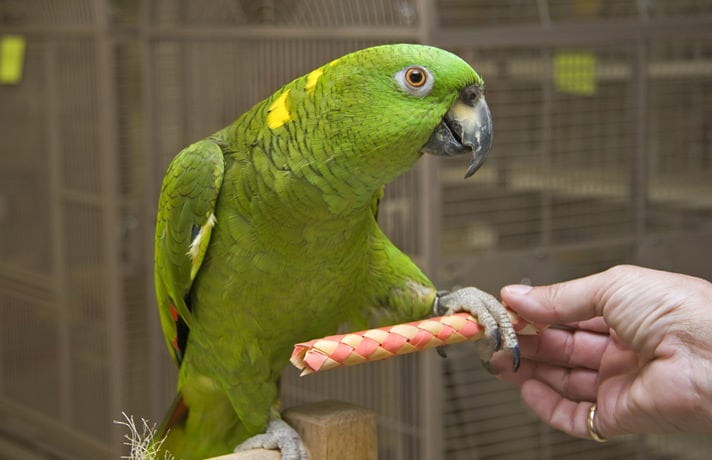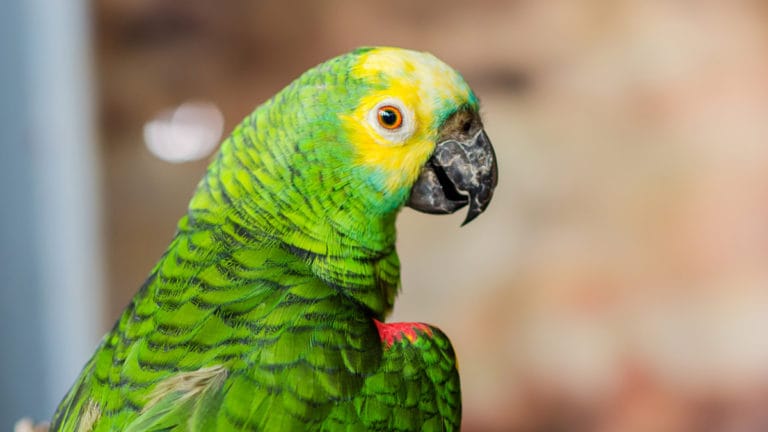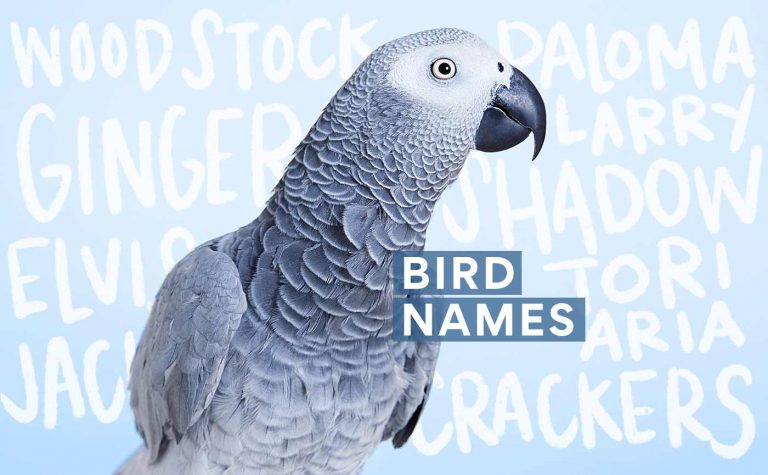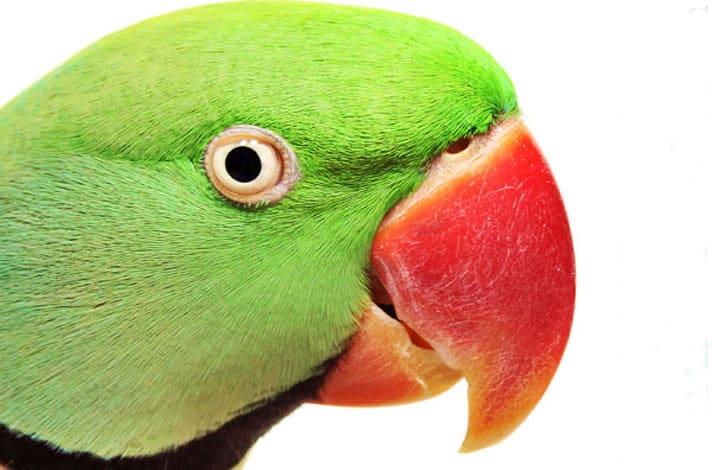Top 10 Pet Amazon Parrot Question #1
What kind of Amazon parrot do I have? Taxonomists cite 27 species of Amazon parrot in the world. In captivity, you’ll probably find these common Amazon parrots:
- Lilac-crowned or Finsch’s Amazon (Amazona finschi)
- Orange-winged Amazon (A. amazonica)
- Blue-fronted Amazon (A. aestiva)
- Mealy Amazon (A. farinosa)
- Yellow-crowned or yellow-fronted Amazon (A. ochrocephala)
- Double yellow-headed Amazon (A. o. oratix)
- White-fronted or spectacled Amazon (A. albifrons)
- Green cheeked or red-crowned Amazon (A. viridigenalis)
- Yellow-naped Amazon (A. auropalliata)
- Cuban Amazon (A. leucocephala)
Each offer their own personality traits and beautiful feather coloring.
Top 10 Pet Amazon Parrot Question #2
Is my pet Amazon parrot male or female? Some Amazon parrots are sexually dimorphic (distinguishable between male and female) in subtle ways. The white-fronted Amazon parrot, for example, is such a bird. In an adult male the alula and primary covert feathers are red; in the female they are green. Most Amazon parrots, however, will require a DNA test to determine their sex.
Top 10 Pet Amazon Parrot Question #3
What should my pet Amazon parrot eat? As arboreal foragers in their native South and Central America and islands, Amazon parrots eat tree nuts, fruit, vegetables and the occasional grub. Your pet Amazon will enjoy fresh produce, raw or cooked, supplemented with a formulated diet (i.e. pellets). Like all parrots, Amazons need Vitamins A, K, E and calcium in their diets. Carrots, pumpkin, squash, sweet potatoes, papaya, cantaloupe and mango are good sources of Vitamin A. Calcium is present in food like peas, broccoli, almonds and Brazil nuts. Bell peppers are also good sources of A, K and E. Limit nuts to treats, as well as people food.
Pet Amazon parrots will never say no to your food (don’t feed them avocado, chocolate, alcohol or caffeine), but too much of that can be bad for their health.
Top 10 Pet Amazon Parrot Question #4
What kind of cage should I get for my pet Amazon parrot? At an average of 13 inches tall, Amazon parrots require plenty of room inside their pet bird cage. Choose a cage at least 3 feet square and 4 feet high in size. As with any pet parrot, purchase the largest cage that you can afford and accommodate.
Stock the cage with ample perches and pet bird toys. Buy playgyms and perches to give your pet Amazon places to stretch out and exercise.
Top 10 Pet Amazon Parrot Question #5
Do Amazon parrots learn to talk? Yes, many Amazon parrot do mimic human speech. According to experts, the best talking species tend to be the blue-fronted, yellow-naped and double yellow-headed Amazons. They also say mealy Amazons and orange-winged Amazons, as a rule, tend not to talk as well as blue fronts and yellow napes. Encourage your pet Amazon to talk by using certain phrases frequently around your parrot and associating words with objects or actions.
Top 10 Pet Amazon Parrot Question #6
What’s the best way to train my pet Amazon parrot? Amazon parrots can learn many tricks. Positive reinforcement and structured training sessions will go a long way in taming and trick-training your pet Amazon. These parrots are motivated by food and will work for nuts. Start with the essential behavior training tools of the Step Up command and the contact call. A good, more-advanced, trick to try is the wave.
Top 10 Pet Amazon Parrot Question #7
How should I enrich my Amazon parrot’s life? Amazon parrots hail from rain forests and relish the rainwater. Your pet Amazon will enjoy frequent baths from a spray bottle or shower. Amazon parrots live in flocks in their native environment, and seek out similar companionship in their domestic dwellings. Interact frequently with your pet Amazon; allow it to spend time around your family by perching it in playstands in social areas in the house, such as the family room (never the kitchen, where dangers exist).
Top 10 Pet Amazon Parrot Question #8
Do Amazon parrots contract certain diseases? Amazon parrots stay very healthy with the proper care, but occasional illnesses affect them. Intestinal inflammation (Enteritis) is fairly common in all parrots and results in loose stool and decreased appetite. Respiratory infections — bacterial, viral or nutritional — affect Amazon parrots. Avoid these infections from nutritional deficiencies by providing plenty of Vitamin A, which Amazon parrots can lack in their diet. A feather stain above the cere signifies this nutritional disorder. Talk to your avian veterinarian to learn more about diseases that can affect Amazon parrots.
Top 10 Pet Amazon Parrot Question #9
How can I tell if my pet Amazon is sick? Sick Amazon parrots can display a few common symptoms. Your pet Amazon might have perpetually ruffled feathers, rest frequently with its head turned back and often on the bottom of its cage. Additionally, several other symptoms indicate illness such as frequent sneezing, damp nostrils changed feces or cloudy eyes. Some signs of illness will be hard to detect; as prey animals, parrots disguise symptoms of sickness to fool predators. Review some common parrot symptoms to see if your pet bird is ill and take it to your avian veterinarian immediately.
Top 10 Pet Amazon Parrot Question #10
Can Amazon parrots have behavior concerns? Energetic and curious, Amazon parrots do exhibit some behavior concerns if unable to express themselves. They can display aggressive tendencies upon reaching sexual maturity, sometimes more strongly than other large parrots, but this varies from bird to bird. Your pet Amazon parrot might also vocalize loudly, particularly in the morning and evening when it would be communicating with its flock. Consideration for this natural tendency, as well as some vocalization modification tips, can help you cope with this exuberant exhibition.
Posted By: Petcha Editors
Featured Image: Via Jill Lang/Shutterstock
Share:









